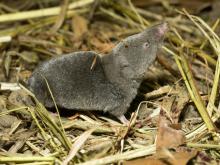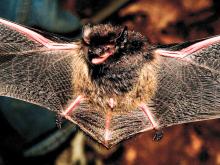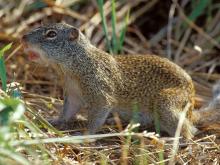Mammals
Media

Species Types
Scientific Name
Scalopus aquaticus
Description
Eastern moles are plush-furred, large-handed critters infamous for disfiguring lawns as they tunnel belowground hunting for grubs and cutworms — many of which are also dreaded by landscapers!
Media

Species Types
Scientific Name
Sorex, Blarina, and Cryptotis spp.
Description
Six species of shrews occur in Missouri. They are mouselike but do not have the chisel-like front teeth of rodents. Instead, they have sharp, spiky teeth for hunting prey.
Media

Species Types
Scientific Name
Odocoileus virginianus
Description
In summer, white-tailed deer are reddish-brown to tan above; in winter, they are grayish. The throat and belly are white. This common Missouri deer is named for the bright white of its flaglike tail.
Media

Species Types
Scientific Name
Sus scrofa
Description
Feral hogs cause millions of dollars in agricultural, environmental, and property damage. As they root and wallow, they plow the soil to depths of 2–8 inches — sometimes for many acres! And this is just the beginning of the trouble they can cause to humans, livestock, and the environment.
Media

Species Types
Scientific Name
Myotis lucifugus
Description
The little brown myotis (little brown bat) is one of our most common bats, but populations are declining. White-nose syndrome has taken a heavy toll in northeastern states. This species is now listed as vulnerable across its range.
Media

Species Types
Scientific Name
About 14 species in Missouri
Description
Bats are the only mammals capable of sustained flight. At least 14 species of bats occur in Missouri; they are all relatively small, and they eat insects. Many of them are declining.
Media

Species Types
Scientific Name
Dasypus novemcinctus
Description
There’s no other animal in Missouri that can be mistaken for an armadillo! In the 1950s, they were not considered residents, but now they are regularly found in the southern half of the state.
Media

Species Types
Scientific Name
Peromyscus maniculatus
Description
The deer mouse is found statewide, usually in open habitats like fields and grasslands. It and our other three species of Peromyscus mice look a lot alike.
Media

Species Types
Scientific Name
Poliocitellus franklinii (formerly Spermophilus franklinii)
Description
Franklin’s ground squirrel is brownish gray speckled with black, looking a little like an eastern gray squirrel but with a less bushy tail and smaller ears. It occurs in and near grasslands in the northern quarter of Missouri.
Media

Species Types
Scientific Name
Canis latrans
Description
The coyote is a much-maligned member of the dog family. It does a great service to the ecosystem by helping to hold populations of rabbits and mice in check. In addition, their yips and barks add to nature's music to rural nights.
See Also
About Mammals in Missouri
More than 70 species of wild mammals live in Missouri: opossums; shrews and moles; bats; rabbits; woodchuck, squirrels, beaver, mice, voles, and other rodents; coyote, foxes, bear, raccoon, weasels, otter, mink, skunks, bobcat, and other carnivores; deer and elk; and more. Most of us recognize mammals easily — they have fur, are warm-blooded, nurse their young, and breathe air.





















